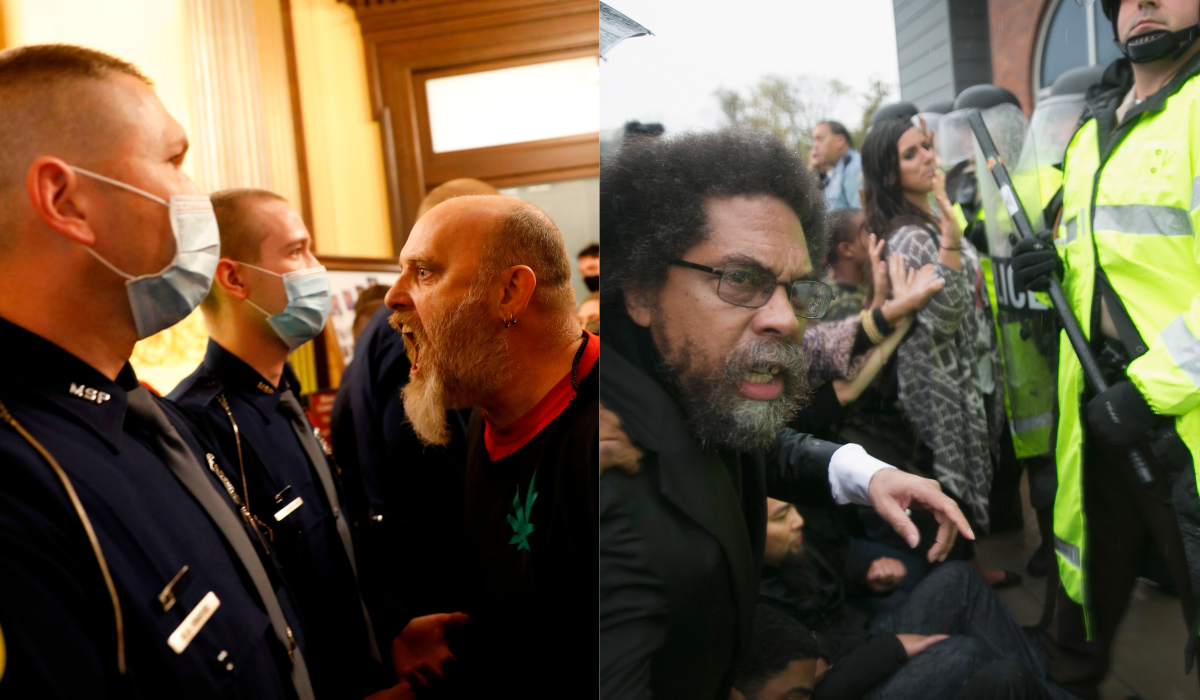On April 30, a group of the tackiest, halitosis-slanging white supremacists barged into Michigan’s capitol building to voice their baseless grievances against Big Gretch’s stay-home ordinance. This heinous show of idiocy is expected from our mayonnaise-infused brethren who are always, so trigger happy. Aside from these murderous thugs stomping around in confederate couture demanding to be let free from the confines that their leader built — sadly and to no surprise — they were treated quite differently than Black civilians.
Why were these terrorists allowed to “exercise their rights” but Black protesters have been maimed and tortured for doing the same? We’ve compiled nine examples of how Black people have been treated differently than our white counterparts when it comes to practicing our political freedoms.
1. The Little Rock Nine
What was your high school experience like? How would you feel if the National Guard had to escort you into school because there were literal mobs of white folks preventing you from entering? That was the experience of “The Little Rock Nine,” the first African-American students to enroll at Little Rock Central High School. How horrific it must’ve been for them to have entitled racists shouting vulgarities at them for simply walking into school — which is a basic right.
2. The Ferguson Protests
In August of 2014, 18-year-old Michael Brown was murdered in cold blood by police officer, Darren Wilson. One year later, to acknowledge the first anniversary of the slain teen’s death, citizens took to the streets to peacefully protest. These Black activists were arrested for using their voices while the white supremacists in Michigan were recently allowed to saunter through the capitol with choppas and soiled clothes.
3. The Birmingham Campaign
In 1963, The Birmingham Campaign was implemented to address Alabama’s economic policies that discriminated against Black people. In the end, many businesses became accessible to Black residents, but not without pain. While the nonviolent protest consisted of sit-ins and marches, the police countered the peaceful tactics with dogs and water hoses.
4. Bloody Sunday
In 1965, Representative John Lewis (then chairman of the Student Nonviolent Coordinating Committee) co-led a peaceful march from Selma to Alabama’s state capital, Montgomery. The march was created to protest the lack of voting rights that fell upon Black people. The rally became anything but peaceful, as white counter-protesters decided to viciously beat the Black demonstrators, even killing one.
5. The Gin Bottle Race Riot
A store owner accused Chicago resident Blondella Woods of stealing a liquor bottle. As a result, Woods was wrestled to the ground like an animal. The next day, over 100 community members gathered to protest the injustice. How did law enforcement handle this? Tear Gas, of course.
6. 1964 Cambridge (Maryland) Protests
When infamous segregationist and former Alabama Governor George C. Wallace came to Cambridge in 1964 for a speech, tear gas was used there too. The National Guard decided to intervene and attack the demonstrators who did not want Wallace and his fiery views present.
7. 1964 Civil Rights Swim-In
Imagine swimming peacefully with your homies in a pool then being dragged out of the pool like vermin? That’s what happened when a group of Black protesters participated in the Monson Motor Lodge swim-in. Scheduled to coincide with the larger civil rights movement, Black demonstrators swam in the whites-only pool located in St. Augustine, Florida. The owner of the hotel poured acid in the pool and the protesters were eventually sent to jail.
8. 1961 Freedom Rides
In 1961, Black freedom riders bused down to southern states to participate in the “freedom rides.” At each stop, they were to head into segregated areas, but in Alabama the situation went haywire. One of the buses was set on fire while white supremacists attacked exiting passengers. Another bus was invaded by a group of white men who savagely beat the non-violent protesters onboard.
9. Watts Rebellion
In 1967, step brothers Marquette and Ronald Frye were stopped by a highway patrol officer in Watts. A crowd gathered to watch the ordeal and an altercation broke out with one of the crowd members and a backup officer. The step brothers’ mother also arrived on the scene and was physically assaulted by police officers while trying to protect her son. The incident launched into a chaotic multi-day rebellion.
Note: media from the Charlotte protest and Princess Ann, Maryland protest were used to visualize the Gin Bottle protest and Cambridge, Maryland protest respectively.
